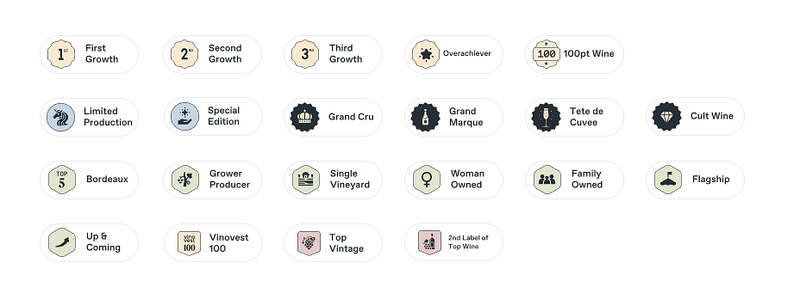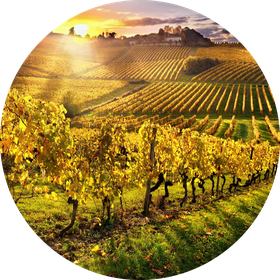Vinovest Quarterly Report, Q1 2023
What a quarter it’s been. Silicon Valley Bank and Credit Suisse collapsed. The stablecoin USDC lost its peg to the dollar. Now, there’s fear that this financial contagion might spread to other banks and digital assets. Yikes.
If you want a reprieve from the chaos, you’ve come to the right place. Fine wine has long been a safe haven during uncertain times, and this quarter has been no exception. Here are the biggest stories you need to know from the first quarter of 2023.
Further reading
- Want to build a profitable wine investment portfolio? Check out the smartest way to Invest In Wine Through Vinovest.
- If you’d like to invest in extraordinary whiskies, don’t miss our comprehensive Whiskey Investment Guide.
By The Numbers
1.28% - The average return of Vinovest portfolios in the first quarter of 2023
56.5% - The return of 2019 Domaine Jean Louis Chave Hermitage Rouge, the best performance of any wine in the first quarter
77% - Merchants who were optimistic or neutral about the fine wine market in 2023, according to a Liv-ex survey. (For more predictions, skip to “Investing Outlook for Q2”).
39% - Percent of ultra-high net worth individuals likely to invest in fine wine this year, according to the Knight Frank Wealth Report
21 - New badges being added across Vinovest to highlight notable characteristics of each wine. (To learn more about badges, skip to this section.)
Fine Wine Performance in Q1
Fine wine was solid but unspectacular in the first quarter of 2023, with the average Vinovestor watching their portfolio grow 1.28% in value. What events shaped that figure? Here are a couple that stood out:
1) Burgundy and Champagne Prices Coming Back to Earth
Burgundy and Champagne were the top-performing wine regions in 2022. According to Liv-ex, Burgundy notched an industry-leading 26.7% return, while Champagne grew 18.7%. Part of that growth came from robust demand for top labels, some of which are now facing a cooling-off period.
With these two regions plateauing in the first quarter, it’s fair to wonder if buyers are adjusting their purchasing habits. After all, many economists are predicting a recession. As a result, some people who invest in grand cru Burgundy may be opting for premier cru wines, which still offer high quality but at a lower price point.
This trajectory shouldn’t come as a surprise. Per our Q3 2022 report, auctioneer Charles Antin predicted, “We’re still setting world records for certain wines, but the graph can’t go up as steeply as it has, forever. My prediction is a cooling off, not a falling, but continuing to rise in the long run.”
2) Demand for Fine Wine Grows in Asia
In December, China began rolling back its strict anti-Covid-19 policies. That was good news for wine lovers yearning to restock their collections. The country’s zero-Covid policy and city-wide lockdowns stifled trade in the second half of 2022. With lockdowns disappearing, the Chinese economy and the wine trade are poised to pick up again.
One region that stands to benefit is Bordeaux. The soaring prices of Burgundy and Champagne have boosted Bordeaux’s relative value. Moreover, Asian collectors have a long history of seeking out the most famous and prestigious labels for their personal collections, in particular first growth Bordeaux. In fact, four of the five most traded wines in China and Hong Kong came from Bordeaux in 2022.
Don’t overlook Burgundy, though. The relatively small volume of the Burgundy 2021 en primeur campaign means that the latest Burgundies should trade at a premium. That limited availability should only amplify consumer focus on the region and help mitigate any dip in price.
Financial Markets in Q1
The banking crisis and continued Fed rate hikes have folks on edge. Still, there is reason for optimism. US financial assets demonstrated broad gains in the first quarter of 2023, though getting from January 1 to March 31 wasn’t always a straight line.
The S&P 500 had an up-and-down quarter. The index finished January on an upswing, then crumbled in February before finally surging in March. Meanwhile, the Nasdaq jumped nearly 17%, making it the best three-month stretch for the index since the fourth quarter of 2020.
Bonds climbed, a sign that investors think the Federal Reserve won’t raise rates as high as anticipated, likely due to the turmoil in the banking sector. (More to come on this.) The jump offers a temporary salve. US treasuries had their worst year in decades in 2022, thanks to more hikes than a weekend at Yosemite.
Here’s a snapshot of how major assets performed in the first quarter:

Source: Investopedia
Despite the failure of Silvergate Bank, a platform that provided financial services for cryptocurrency users, crypto was a massive winner in the first quarter. Bitcoin and Ethereum finished the quarter up +71.4% and +52.3%, respectively. The gains may signal investors’ desire to find safer alternatives amid widespread banking issues.
Without a doubt, these broad gains are a positive sign for the US economy. It’s not quite time to bust out the Champagne, though. High inflation (6.04%) still presents a looming concern. If rising prices remain a driving force on the market, it could result in economic bumpiness in the near future.
As head of investment strategy at SoFi Technologies, Liz Young said in an interview with CNN Business, “I just don’t think that we’re going to get inflation down without seeing pain in the market. So, in order for it to stabilize, I think firstly we probably have to give some of these rallies back.”
The 7 Biggest Stories from Q1
1) Silicon Valley Bank Collapse Shakes Wine Industry

Banks have had a rough few months. Signature Bank, Credit Suisse, and Silvergate collapsed, and people are worried that this trend might ripple through the banking sector. However, no collapse had more impact on the wine industry than that of Silicon Valley Bank.
Silicon Valley Bank (SVB) was a commercial bank headquartered in the Bay Area, designed to meet the needs of local tech companies. Before its collapse, Silicon Valley Bank was the 16th largest in the United States, and more than half of ventured-bank tech startups banked there. (Side note: Vinovest did not bank with SVB at the time of its collapse.)
SVB had particularly deep ties within the fine wine industry, with more than 400 winery clients. Not only did many in the wine community have personal and business accounts there, but individuals used SVB to buy new vineyards, expand wineries, and sponsor events. According to Silicon Valley Bank’s website, it loaned more than $4 billion to the wine industry since 1994, with roughly $1.2 billion in outstanding loans.
This close-knit relationship is far from accidental. Winemaking requires a lot of upfront capital, whether to acquire land and vines or purchase fruit, barrels, and winemaking equipment. Plus, winemakers often wait several years before they can sell their wine, making upfront capital vital.
Over the years, SVB developed a unique relationship with the local wine community. Here’s an excerpt from Mitch Frank’s piece on the subject for Wine Spectator:
“Winemakers tell me that SVB was more than a lender. Bank staff sat down with them, shared recent market research, and helped them decide what was best for them, both short and long-term. Adam Lee of Clarice Wine Company told me about the early days of his first winery, Siduri, when he had been paying the bills with loans from his mom. An SVB banker sat down, tasted his wines with him, asked him about his goals, and helped him develop a plan to reach them.”
Fortunately, there is good news amid the collapse. Shortly after the SVB Financial Group filed for bankruptcy, the federal government announced that it would cover all customer deposits, including funds over $250,000 (the usual FDIC limit.) Customers have since been able to withdraw money, though their loans, lines of credit, and other business accounts remain in limbo.
2) ChatGPT Passes Three Levels of the Master Sommelier Exam
No, ChatGPT isn’t going to take all our jobs away, but sometimes it feels like it’s eerily close to doing so. So imagine our surprise with we heard that ChatGPT passed three levels of the master sommelier exam. As a point of reference, only 25% of humans pass these tests.
For many, becoming a master sommelier is a dream job. It’s a passion few know and even fewer achieve. That made it a little disconcerting that ChatGPT passed all three parts with flying colors. To be exact, the AI scored:
- 92% on the introductory Court of Master Sommelier test
- 86% on the Certified Sommelier exam
- 77% on the Advanced Sommelier exam
What a world. On the upside, ChapGPT will never understand what it’s like to enjoy a glass of 2012 Chateau Lafite Rothschild, so that’s a comforting thought.
3) Winemaker Axel Heinz Steps Down from Ornellaia and Masseto
On March 23, Axel Heinz – one of Italy’s most celebrated winemakers – stepped down from his role at Ornellaia and Masseto. For anyone with these two Italian wines in their portfolio, that’s likely good news.
There is a buying frenzy on the secondary market as collectors grab up as much of Heinz’s remaining wine as possible. Case and point: 2010 Ornellaia was up 15% month-over-month on March 31, according to Liv-ex. After all, the new winemaker will have a different style, meaning there will never be another Ornellaia or Masseto quite like Heinz’s.
Similar phenomena have happened before with the retirement of winemaking legends Henri Jayer and Noël Verset. Keep your eyes on the prices of Ornellaia and Masseto in the coming months.
4) Scotch Exports Hit £6 Billion in 2022

Whether times are good or bad, fine whisky never goes out of style. In 2022 and despite considerable economic headwinds, scotch whisky exports reached a record high of £6.2 billion. That represents a 37% increase in value from the previous year.
Whisky markets in the European Union saw strong growth in 2022, including Germany, France, and Spain. However, it was Asia that contributed most to the boom. China, Singapore, Taiwan, and India each saw double-digit growth, and that upward trajectory might just be starting.
Currently, scotch whisky only accounts for 2% of the Indian whiskey market. The Scotch Whisky Association suggests that a UK-India free trade deal would decrease India’s 150% tariff on scotch. If that happens, experts anticipate an extra £1 billion of growth over the next half-decade for the scotch industry.
5) Vinovest Closes Client-Only Fundraising Round
Throughout February, our co-founder and CEO, Anthony Zhang, held a special fundraising round. Normally, this process involves pitching venture capital firms on Vinovest. Things were a little different this time - we only opened the round to Vinovest clients.
Now, I’ve been sworn to secrecy about how much we raised and how many investors we had. (Sorry!) But I can say this - the amount of interest exceeded expectations. In fact, we raised 150% of our goal amount.
So, to all our clients, thank you for making Vinovest possible.
6) Vinovest Adds New Features to Improve User Education

With banks imploding and inflation still higher than we’d like, you’ve probably found yourself brushing up on smart money moves. That financial refresh comes just in time. After all, April is Financial Literacy Month. To celebrate, Vinovest is adding two new features to make investing even simpler.
First are 21 badges highlighting the characteristics that make each wine on our platform unique. For instance, the “Grand Cru” badge is reserved for wines from France’s most prestigious vineyards. Meanwhile, the “Limited Production” badge means that the winery produces fewer than 500 cases per year on average.
Second, we’re adding new insights about the most popular wine regions. These pages cover what makes a region portfolio-worthy, the latest news, and things to watch for in the future. You can find these insights for wines from the following regions:
- Bordeaux
- Burgundy
- Champagne
- Napa Valley
- The Rhône
- Tuscany
Here’s how to find these insights. Let’s say you own 2016 Château Margaux, a first growth Bordeaux, and want to learn more about the region. Click on the link above, scroll to “Region Info” and click “Read More.”
7) Coming To You Live From Krug

With the new year came new goals for everyone, including the Vinovest team. One of our main goals was to provide even more value for our users. So, we started a new monthly webinar series.
In January, our winery relations managers, Fabrice Georges and Olivier Bouchard, hosted a webinar at the Champagne house, Krug. For the uninitiated, Krug is home to some of the most revered Champagnes anywhere. According to Wine-Searcher, Krug is the third most sought-after Champagne in the world, behind only Dom Pérignon and Cristal.
During the webinar, our team picked the brains of Krug president Manual Reman and its business development manager Louis Henrion on the past, present, and future of the Champagne industry.
Now, we don’t want to spoil the entire thing for you. Instead, go watch the webinar for free in the Vinovest Community.
Investing Outlook for Q2
Bittersweet Chaos for Fine Wine Industry
The general uncertainty surrounding the economy has been bittersweet for fine wine. Let’s start with the bitter part. The US economy has been in a precarious place with high inflation, bank collapses, and a potential recession on the horizon. Even if the United States ends up with a lowercase “r” recession, the foreseeable financial future is not one filled with sunshine and rainbows.
Concerns in the banking industry have led some people to flee traditional assets in search of safer alternatives. Fine wine has been a popular choice of refuge. According to the Knight Frank Wealth Report, 39% of ultra-high-net-worth individuals will likely invest in fine wine in 2023.
Considering the historical performance of fine wine, it’s hard to argue. After all, fine wine has:
- A low correlation with the stock market (0.12, to be exact)
- 10.6% annualized returns over the last three decades
- Roughly 1/3 the volatility of global equities
Over the next year or two, the US economy will undoubtedly have its highs and lows. Those waves should have a minimal impact on fine wine. Fine wine’s low correlation with traditional assets like stocks and bonds is why many consider it a safe haven against economic volatility.
Expert Predictions for Q2
In January, we came to our wine experts with a question. “What’s in store for fine wine in 2023?” They each looked into their crystal balls, and here is what they saw.
What will be the top-performing wine region of 2023?
Liz Dowty-Mitchell, Head of Wine: Burgundy. The demand is just too high, and the supply is not able to keep up coming off of a string of small vintages.
Olivier Bouchard, Winery Relations Manager: Champagne. Demand keeps going up.
Fabrice Georges, Wine Relations Manager: The 2021 primeurs release has had incredibly low volume and high prices. That will drive the Burgundy market once again above all others.
What under-the-radar winery or wine region will have a breakout year?
Dowty-Mitchell: Northern Rhône. It’s hard to beat the combination of performance, price, and stability.
Bouchard: Tuscany will break out in the years to come, and not just Super Tuscans.
Georges: Beausejour Becot in Saint-Émilion might surprise everyone. More to come in May with the launch of the 2022 primeurs campaign
What trends are you watching in the wine industry?
Dowty-Mitchell: The response to climate change in vineyards and worldwide environmental, social, and governance (ESG) regulations impacting the wine industry.
Bouchard: Two things.1) Champagne's continuous ascent in the wine industry and 2) wineries as they transition to biodynamic practices across the world.
Georges: The irresistible rise of Champagne on the secondary market and the organic and biodynamic trend in vineyards.
The global economic forecast looks grim. How will that impact the wine industry in the near future?
Dowty-Mitchell: All the more reason to diversify and invest in an asset that is recession-resistant and is mostly immune to the fluctuations in the market.
Bouchard: Wine prices are not as impacted by economic cycles as other assets. I foresee less trading in the industry but not much impact on prices. The ones at real risk are wineries that have recently exploded to unseen levels before prices. Their new prices will be hard to maintain in a bearish market.
Georges: To echo Liz, fine wine is recession-resistant, but it only concerns top wineries. For other wineries, global inflation might negatively affect the consumption of "daily" wines.
TL;DR
Quarterly reports are long, so let’s keep this short. Here’s the 30-second version of our report.
- The average wine portfolio at Vinovest grew 1.28% in the first quarter
- Multiple bank collapses sent shockwaves through the economy
- Scotch whisky exports reached a record high in 2022
- New educational features are coming to Vinovest in April
- A majority of wine merchants are optimistic or neutral about the future of fine wine



